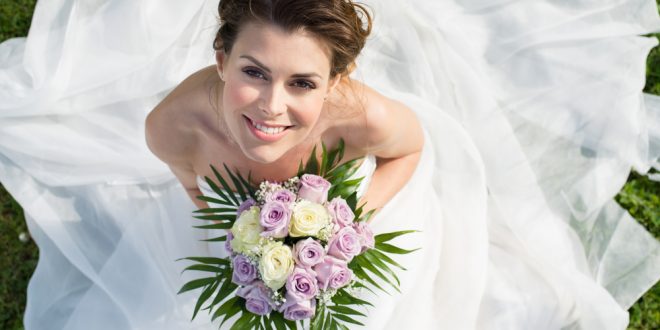The Ceremony
The wedding may take place in a church, rectory, synagogue, mosque, meeting hall, hotel, country club, judge’s chambers, private home, military chapel, or on a beach. Arrive at least fifteen minutes early for the ceremony. If there is a guest book, the guest signs his or her name without a title (no Mr., Mrs., Ms., Miss, or Dr.). Sign it “Lyn and Edwin Flores.” You may also leave a little message just to the side of your name such as, “Much happiness” or something similar and very short.
For an indoor wedding, there may be ushers at the door who will walk you to your seat. You may be asked if you are a “friend of the bride” or a “friend of the groom.” This question is generally asked at formal weddings. Friends of the bride are traditionally seated on the right side of the church, synagogue, or hall, and friends of the groom are seated on the left.
Usually the groomsmen, best man and groom (sometimes escorted by his parents) enter first. Then the bridesmaids, maid of honor and matron of honor enter the sanctuary. The bride, usually escorted by her father, her mother, both parents, or other well-loved figure, enters last. This happy trail of people can be large or very small. This entering group is called the processional.
Many religions stand when the processional begins. Be aware that in some faiths you do not stand when the processional begins. If you are unsure, watch the couple’s family members (usually seated in the first two rows) for guidance.
When the ceremony is complete, the happy couple, and immediately after them, the entire bridal party exit the room. This group is called the recessional. Allow the guests seated in the first rows to exit first with subsequent rows following. There may be a receiving line immediately after the ceremony.
The Receiving Line
The purpose of the receiving line is to give the bride and groom an opportunity to formally greet every person who attended their wedding ceremony. Generally the bride’s and groom’s parents, then the bride and groom, followed by members of the bridal party are in the receiving line. Sometimes the receiving line is much shorter.
Do not take a drink with you to the receiving line. Walk through the receiving line. Introduce yourself to the family. Say something like, “The ceremony was just beautiful.” Never congratulate the bride. Wish the bride “much happiness.” Offer your congratulations to the groom.
At large and very formal weddings, the guests may first be directed to stand in a smaller line called a reception line. The reception line leads to the receiving line. In the reception line an introducer will ask your name and walk you over to the receiving line. He or she will whisper your name to the first person in the receiving line; this is usually the bride’s mother. The bride’s mother then introduces you to the next person in line and so on.
Table Number Cards and Place Cards
At large weddings table number cards are placed into small envelopes. The envelopes are arranged in alphabetical order on an entry table. The guest takes the envelope that has his or her name written on it. Inside the envelope there is a card on which the table number is written. These envelopes and their contents are sometimes referred to as escort cards.
A place card is about the size of a business card. Each guest’s name is written on an individual place card which is preset on the dining tables. Never trade places with another guest if you have been assigned a specific place at the table.
At formal weddings only the guest’s last names and titles are used: Ms. Gardener, Dr. Suarez, Mayor Silver. At informal weddings and dinners the guest’s first and last names are used: Susan Gardener, George Suarez, Jonathan Silver.
Dancing
No matter what, the first dance belongs to the bride and groom. Then, traditionally, the bride dances with her father and the groom with his mother. Depending on the formality of the wedding, eventually, fathers, daughters, mothers, fathers and in-laws all dance with each other. After the bridesmaids and ushers have started to dance, all guests may enjoy the dance floor.
Toasting
The toasting begins with the dessert course at a formal lunch or dinner reception. For an afternoon reception, the toasting begins when the couple has had their first dance. The best man is the toastmaster and he has pre-arranged the number of people toasting. He makes the first toast. Then the groom toasts the bride and the bride toasts the groom. The bride’s father is next. Toasts should be short. They may be sentimental or they may be witty; but they are never suggestive or embarrassing.
Cutting the Cake
The polite guest never leaves a wedding until the cake is cut. The cake is cut right before the dessert course is served. Or, the cake may be the lone dessert.
At an afternoon reception, the cake is cut after the toasts have been made. The bride and groom take turns feeding each other a little bit of the cake and then slices of cake are cut and served to the guests. Suggestion: see that the couple is supplied with a fork to use when feeding each other cake. No bride wants to look at her wedding pictures and see icing on her face, fingers and possibly her gown.
Throwing the Bride’s Bouquet
Traditionally, the bride throws her bouquet to her attendants and other single female guests at the end of the wedding. Custom has it that the woman who catches the bouquet will be the next to marry. At some weddings, the groom removes the bride’s garter from her leg and throws it to his ushers and other single male guests. The thought is that this man will be the next to marry. Since some brides are uncomfortable with this activity, it is up to the bride and groom to decide if they wish to include taking the garter off of the bride’s leg as a part of the reception.
Your Job as a Guest – Some Final Tips
Unless you have been specifically asked to do so, please do not take flash pictures during the wedding ceremony. This is an etiquette blunder and is actually very annoying to the rest of the guests. Taking pictures during the ceremony is the job of the official wedding photographer. Please do not get in the way of the official photographer.
The bride and groom may have hired a professional videographer. With this in mind, if your children have specifically been invited to the wedding (their names are on the invitation), please consider whether they are old enough not to interrupt the ceremony. Do you really want your dear friends to hear a crying child on their wedding sound track?
Unless otherwise directed by the bride and groom, please wait a day to post pictures of the wedding on social media. Let the happy couple have a chance to do this first. It’s their day to sparkle. Please do not take this happiness away from them.
Most important! Do not forget to turn your cell phone off and put it away before the ceremony begins.
Remember to find and thank the hosts of the wedding before you leave the party. I know that you will hand-write the hosts a thank-you note (right away) letting them know how lovely the wedding was and how much you enjoyed it.
Now relax and have a wonderful time!
Excerpts of blog taken from the book: Hospitality Management – People Skills & Manners on and off the Job. Copyright © 2015 Lyn Pont, PhD
“Pont’s book is a must-read for anyone considering a career in hospitality.”
— Isadore Sharp, chairman and founder, Four Seasons Hotels and Resorts
See the book at: www.HospitalityManners.com
Visit Lyn at: www.MannersForBusiness.com
Lyn Pont, Ph.D. – World’s Top 30 Hospitality Professionals, – Global Gurus
#weddings, #hospitality, #dining, #etiquette, #tourism, #hotels, #guests, #business, #culture, #celebrations, #engagements, #marriage, #party




